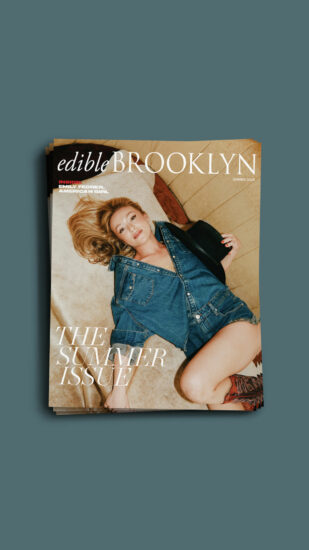
In light of the current ban on immigration from seven countries enacted Friday in an executive order by President Trump, we have gathered up stories from our archives that celebrate the richness and diversity of the cuisines and cultures of some of those affected countries. From Syrian bread to the Persian New Year, these stories are a celebration of how our city eats, drinks and makes.
The Road to Damascus, Through Dumbo
The Damascus Bakery has been headquartered at 56 Gold Street since 1979, but third-generation baker and co-owner Edward Mafoud is quick to note they have been making pita in Brooklyn since 1930. That was the year Mafoud’s maternal grandfather, Damascus native Hassan Halaby, began selling “Syrian bread” on Atlantic Avenue to meet the demand of an increasing population of Brooklynites who—like him—had emigrated from Syria or Lebanon.
But as Brooklyn changed over time, Hassan Halaby—and later, his American-born, Lebanese son-in-law, father to Edward and his brother and co-owner, David—found that the market for their whole-grain, slightly fermented flatbreads did, too. The “health-conscious 1970s—Dr. Pritikin!” Mafoud recalls with a smile—lured a new audience to Atlantic Avenue, as did the rise of falafel and souvlaki shops, the rock stars of pocket-pita cuisine.
Bonus: A video look inside Damascus Bakery.
Fast All Day, Feast All Night
Aziz Osmani, the manager of Kalustyan’s, Murray Hill’s international provisions emporium, is used to placing big orders from local and global suppliers—for, say, their 50 varieties of rice, or two dozen variations on the humble lentil. Deliveries often arrive on pallets stacked with 25-kilo burlap sacks. But it’s during Ramadan, the annual month of Islamic fasting, that he needs to make his biggest food orders.
“We order about 5,000 pounds of dates for Ramadan,” says Osmani. “We also need to be fully stocked with ghee and certainly kalijira rice,” he says, mentioning the rare perfumed miniature grain from Bangladesh. “Kalijira is for the precious occasion—weddings, breaking the fast or [the feast] Eid at the end of Ramadan.” Last year, low harvests meant Osmani ran out of the low-yield, high-value rice, but he’s procured a sufficient supply for this year’s celebrations.
Near East (River) Passage
In the short three-block stretch of Atlantic Avenue between Court Street and Hicks, where Brooklyn Heights meets Cobble Hill and the East River sparkles through the arch of the BQE, lies a land rich in the food of the Mediterranean Middle East and the origins of the oldest Arab-American population in Brooklyn. For over a century, Kings County has been home to one of the largest Arab-American communities in the US; Atlantic Avenue is its Main Street.
Why Atlantic Avenue? “I believe this is where they landed,” says Dennis Halaby, owner of Damascus Bakery at no. 195, gesturing in the direction of the Brooklyn Piers. His grandfather Hassan Halaby immigrated to the United States in the 1920s along with a wave of immigrants from what is modern-day Syria and Lebanon.

A Williamsburg Chef Finds Persian Family Ties—and Feasts—Are Long-Lasting
Two truths became evident after I visited Iran for the first time last spring: As a guest in the country, you will always be well fed; and you will never do anything quickly.
Whether sampling date-studded rice and lamb stew from heaping platters set out on long table or a cloth on the living room floor, sipping afternoon tea served with rose- and saffron-scented pastries, or even eating the meals served on even the shortest domestic plane flights, it’s hard to find a moment in the day when an Iranian is not trying, somehow, to get you to eat.
It’s a process that will never be rushed, especially if it involves their country’s other central preoccupation: family.
Bonus: A recipe for Persian-style stuffed grape leaves.
With a Modern Twist, Styling an Ancient Persian Feast
This is the story of how a group of intrepid New Yorkers got together to prep, cook, style, prop, shoot and then devour an Iranian feast for the springtime holiday of Norooz. In the house were photographer Philip Ficks, Iranian-born prop stylist Lili Abir, food stylist Maggie Ruggiero, an Iranian-born food blogger (me) and a home cook par excellence (my mom, Farideh Hooshiar).
Norooz is the name of the ancient celebration of the Persian New Year. The word literally means “New Day” and has traditions of wearing head-to-toe new clothes; turning the house upside down to make it sparkling clean; and ridding oneself of all bad and stale thoughts and belongings. It begins with an exciting countdown of seconds to the exact moment winter ends and spring begins—a celebration of the renewal of life and earth—rooted in Zoroastrianism and celebrated by Iranians of all faiths.
Editor’s note: Norooz arrives around March 21 this year.

In Gardens, Refugees Put Down Roots
A garden is growing in the Bronx. But this is no ordinary square of soil. On 174th Street and East Tremont Avenue, Drew Gardens is a place of peace for new New Yorkers who arguably need it most: refugees from around the world who have fled war and persecution.
“When I came to New York, I felt lost,” recalls Angele, who grew up on her grandmother’s farm in West Cameroon, fled political instability and found refuge in the United States. “All I saw were tall buildings, and I thought, ‘Where am I?’”
This patch of urban earth became her oasis, one where she tends garlic, tomatoes, peppers, even peanuts, which she’ll grind into peanut sauce come September. But she’s put down figurative roots as well. “I have found solace here,” she says. “I sing to my plants, to the grass and the trees. And when I sing, I have hope for a better life.”


